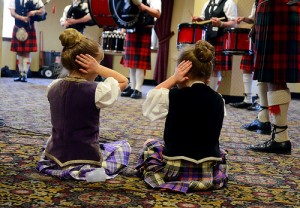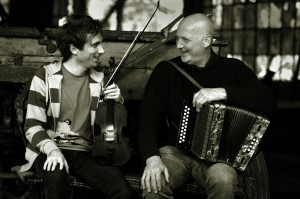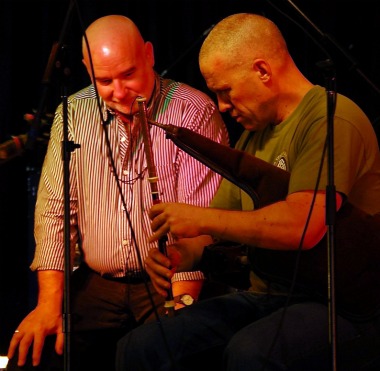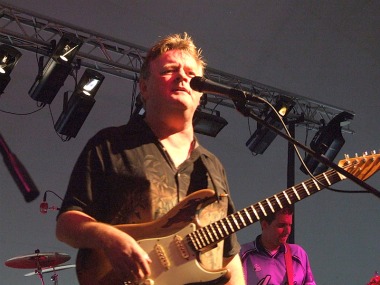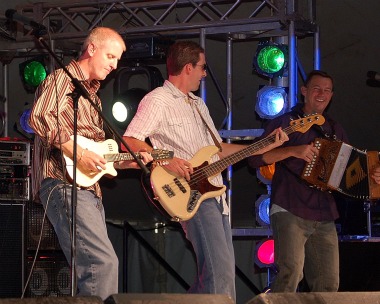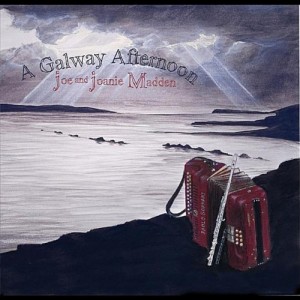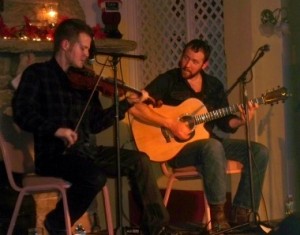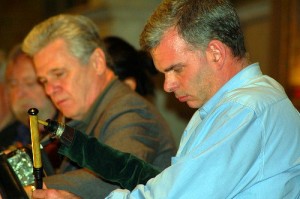
Jerry O'Sullivan, playing at a recent musical benefit at St. Malachy's Church.
Maybe Jerry O’Sullivan would have grown up to be one of the world’s premier uilleann pipers, no matter what. Perhaps he would have popped up on more than 90 albums, played around the world in small spaces and symphonic halls alike, and performed with some of the best musicians on the planet propelled by nothing more than his native talent.
Still, you have to wonder whether O’Sullivan’s journey to the top of trad ever would have happened, were it not for the influence of one retiring but very important man—O’Sullivan’s maternal grandfather.
Andrew Duffy was born in 1899 in Killasser, County Mayo, a townland near Swinford, County Mayo. He emigrated to the New York area in the 1920s. He returned to Ireland only once in his life, in 1963.
Still, Ireland never left him. The traditions and music of Andrew Duffy’s homeland always figured prominently in his life, and he passed them along to Jerry O’Sullivan.
Because of the illness of his mother Frances, much of O’Sullivan’s childhood and early adolescence was spent under the roof of Andrew and Pauline Nolan Duffy in Yonkers. Every Sunday, after Mass, O’Sullivan and his grandfather settled in to listen to Irish music albums.
“He grew up with Irish music and and danced to it when he was a young man,” recalls O’Sullivan. “He had a good ear; his taste was my taste. I was the only member of the family who would sit and listen to it with him.
“I’m sure it meant a lot to him that I listened with him. He was a quiet type of man; he didn’t say too much. if he did say something, it was important. Listening to music was just something we did. I’m sure he liked having my company.”
O’Sullivan credits some of the LPs in his grandfather’s collection with starting him on his way. He recalls one album in particular, recorded in 1962, “The Traditional Dance Music of Ireland” with Peter Carberry and Sean Ryan, a bare-bones pairing of uilleann pipes chanter and fiddle. It made his ears perk up whenever he heard that LP—and he started hearing it at a young age, 4 or 5 years old. O’Sullivan has made a lifelong study of piping and players, but that recording, he admits, influences him still.
It wasn’t until a bit later in his young life that his interest became a full-blown passion. O’Sullivan spent time, off and on, summering and spending holidays with relatives in Ireland. It was during one stay in Dublin at his maternal great uncle Jack Nolan’s house that he became enmeshed in the local traditional music scene.
In this he was helped along by another relative, cousin Tom Dermody, who played button accordion. “He started taking me around to Irish music sessions, and at one a session in the North end I got to really see uilleann pipes up close for the first time, and to talk to the piper for a while.”
Around this time, he was also introduced to piper and renowned pipe maker Matt Kiernan, a retired Garda. O’Sullivan haunted Kiernan’s house at 19 Offaly Road, and ultimately Kiernan was persuaded to make O’Sullivan’ first set of pipes.
Later, after he acquired his pipes, he says, “I started playing with (cousin) Tom; he was somebody I felt comfortable with. Having the experience of playing with him made it more comfortable to play with other people.”
In his travels around Dublin, he also had the opportunity to hear or chat with many of the greats of uilleann piping. including Carberry, Fergus Finnegan and Gay McKeon. When you hear him play today, you might assume he took years of lessons. But that wasn’t the way it was. Most of what he learned came from hearing those pipers and many others, just soaking it all in. It was the old watch, listen and play approach.
“Going back 30-35 years ago, I did have a couple of lessons (with Peter McKenna), but it just wasn’t my experience,” O’Sullivan says. “It was osmosis. It was more listening to the pipes, and some of it was reading articles and books on the subject. There was no formal student-teacher relationship with any one individual.”
For O’Sullivan it was a natural way to learn. By the time he started playing, he had already listened to many recordings of uilleann pipers, he says, “so I knew in my head how it should sound, and that was a huge help.”
Back in New York, he learned more—”a little bit here and a little bit there”—from the great Bill Ochs. Still, he learned most by listening, just as he absorbed every note from his grandfather’s albums.
Actually, in retrospect, those LPs might inspired a very different musical career path. And once again, you have to wonder: What if?
“I always loved listening to the uilleann pipes, but the fiddle was my first choice. (Unfortunately) I didn’t have the contacts with any fiddle players in those days. I wasn’t successful at finding a fiddle instructor,” he recalls.
Once again, the timely intervention of a family member steered O’Sullivan in the direction of uilleann pipes. “My grandmother suggested I join a highland pipe band,” he says. “I did that for a year or two. It was fun for the camaraderie, but musically it was frustrating. The desire to learn uilleann pipes took hold after that. I just thought that as a really neat sounding instrument. There was always something beautiful about the sound. The mechanical end of things was, for a young guy, also appealing. There was a lot of hardware … but that was a secondary thing. The primary thing was just having that sound in my head.”
“I love the fiddle,” he says, looking back on his Irish traditional musical journey. “But I’m glad I picked the uilleann pipes.”
If you haven’t heard O’Sullivan, you can find out for yourself why he made the right choice. (He’s also a dazzling player of Irish wood flute, tin whistle, the low whistle, the highland pipes and the Scottish smallpipes.) O’Sullivan is playing in concert at the Coatesville Traditional Irish Music Series, Sunday, January 30 at 8 p.m. There’s also a preconcert piping workshop. For details, visit http://www.ctims.info/
